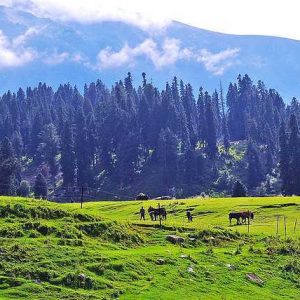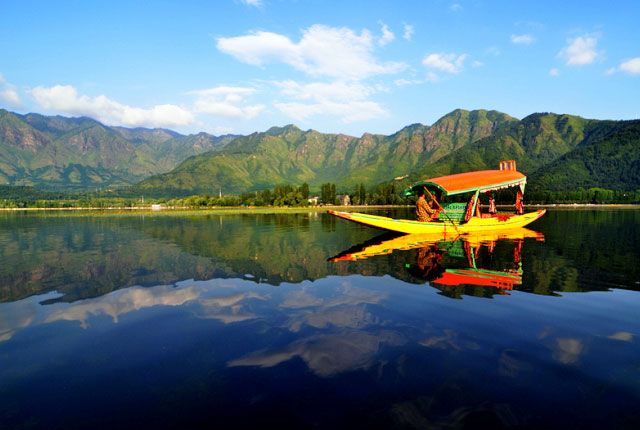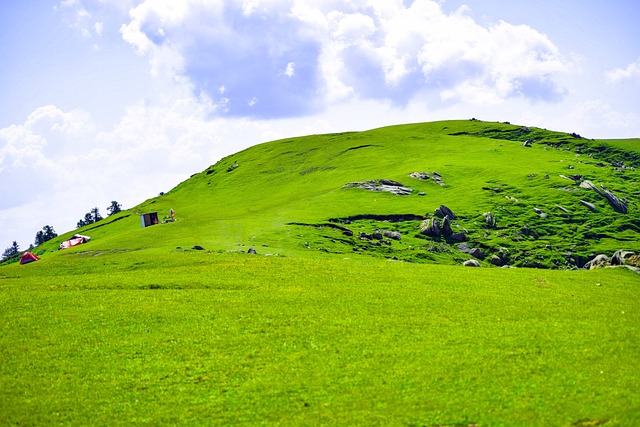
Sacred Temples in Kashmir
Table of Contents
ToggleOverview
Kashmir, long a “Paradise on Earth,” is famous for its shimmering lakes, snow-capped mountains, and green valleys. Beyond its natural beauty, however, is a rich spiritual heritage spun over the centuries: Kashmir’s sacred temples. From sun-worshiping temples on hilltops in ancient days to mystical cave shrines secreted in glaciers, these temples bear testament to the depth of Hindu philosophy, Buddhist scholarship, and Shaivite religion found in Kashmir. In this colorful odyssey, we journey in time and geography to discover the history, architecture, celebrations, and pilgrim routes that render Kashmir’s temples two of India’s holiest places of pilgrimage.





The Spiritual Splendor of Kashmir's Sacred Shrines
Kashmir was a vibrant center of Vedic scholarship and Shaivite devotion even before Buddhism and Islam came to be introduced. Ancient Sanskrit literature such as the Nilamata Purana tells of the divine geography of the valley—mountains, lakes, and rivers—as emanations of the divine forces. Dynasties such as the Karkotas and Utpala kings subsidized the building of temples over the centuries, chiseling granite temples and ordering heavenly stone sculptures. Presently, these old temples in Kashmir await to attract pilgrims and souls seeking, a serene quest for the self.
Historical Significance and Cultural Legacy
Spiritual legacy of Kashmir flourishes from an integration of Vedic, Shaivite, and Tantric. In its classical era (7th–9th centuries CE), under King Lalitaditya Muktapida, Kashmir was a realm of Shaiva philosophy. Scholars such as Abhinavagupta fostered Kashmir Shaivism—a non-dualistic school celebrating oneness of individual soul with universal consciousness. Temples of this golden age were not merely hermitages but academies in which scriptures were debated and rituals conducted with elaborate pomp.
The medieval period was characterized by growth as well as conflict. Islamic rule brought new threads of culture, but a number of temples survived, safeguarded by the local populace. Some of them were destroyed to the point of their very foundations being consumed by time, while others were transformed into Sufi khanqahs with an integration of Islamic and Hindu devotional practices. So sumptuous is the record of change that it is a testament to the vitality of the temple tradition of Kashmir and to the syncretic propensities of the valley.
Main Temples to Visit in Kashmir
1. Kheer Bhawani Temple, Tullamulla
Sitting at the edge of the holy Mansarovar spring in Tullamulla, the Kheer Bhawani Temple is consecrated to Goddess Ragnya Devi (an embodiment of Durga). Pilgrims bring sweet rice pudding (kheer) as an offering to the goddess each spring. Strangely, the spring waters turn pink, white, or blue—celestial signs of divine blessing or omen. This Kashmiri Hindu temple is surrounded by peaceful gardens and chinar trees and both a mystical refuge and a beautiful haven.
2. Shankaracharya Temple, Srinagar
Located on the Shankaracharya Hill overlooking Srinagar, this 9th-century temple is dedicated to Lord Shiva in his incarnation as Shankara. Pilgrims have to climb a steep 350 stone stairs to the shrine, which offers awe-inspiring views of Dal Lake and city skyline. The walls feature delicate carvings of lingams and Nandi bulls, the best of Kashmiri stonework masters. Being the sole remaining ancient Kashmiri temple, it is centuries of Shaivite faith and a peaceful place to meditate in the early sun.
3. Martand Sun Temple, Anantnag
Despite being in glorious ruins now, the Martand Sun Temple remains a witness to the grandiose architectural heritage of Kashmir.
Built in the 8th century by King Lalitaditya, this sandstone wonder used to have a courtyard with colonnades, skyscraper shikharas, and finely carved depictions of gods and stars. A Surya temple, god of the sun, its architecture is such that it faces sunrays on the solstices, flooding the innermost sanctum—a singular combination of astronomical accuracy and religious symbolism.
4. Amarnath Cave Temple, Pahalgam
Situated at 3,888 meters high in the Himalayas, Amarnath Cave Temple is Hinduism’s holiest shrine. Each summer, starting from July to August, thousands of devotees embark on the challenging Amarnath Yatra along picturesque paths via Pahalgam and Baltal. Within the grotto, ice lingams naturally formed—iconic symbols of Lord Shiva—spire within a frozen grotto. The pilgrimage is a test of determination and perseverance, but reaching the cave sanctum is a peak spiritual experience above snow-white mountains.
Architectural Wonders and Cultural Heritage
Temples of Kashmir have a unique vocabulary of architecture drawn from indigenous materials, seismic factors, and Himalayan climatic requirements. Pointers are:
- Stone and Wood Synthesis: Sandstone or granite foundation takes the shape of a wooden superstructure with tiered roofs—a response to colossal snowfall.
- Carved Pillars and Lintels: Highly ornamental floral designs, gods, and mythological beings cover pillars, doorways, and lintels, carved with much accuracy.
- Pagoda-Type Shikharas: In contrast with the high North Indian spires, Kashmiri shikharas are plain and recall one’s memory to Buddhist stupa designs and creating an illusion of harmonizing with Buddhist as well as Hindu temple sceneries.
- Mandapa Halls: Pillared open mandapas provide room for congregational worship and festival dramas and are generally adorned with frescoes and wall paintings.
These Kashmir heritage temples are open-air museums, where each carving and peaceful courtyard is a tale of patronage, devotion, and perfection of art.
Festivals and Celebrations at Kashmir Temples
During the year, Kashmiri temples become raylike hubs of community life with Navratri and Kheer Bhawani Mela, in April, in which thousands of pilgrims take a dip in the holy spring, offer kheer, and rejoice at Durga’s victory through folk dances and singing.
- Mahashivaratri at Shankaracharya: Religious people convene under starry evenings to recite Shiva mantras, oil lamp lighting, and Rudra abhishekam (divine ablution) at the hill temple.
- Chaitra Triodasi at Martand: Even though the Martand temple is ruined, people celebrate Surya as sunrise ceremonies, music concerts, and small shrine worship at the location.
- Amarnath Bhagwati Utsav: Post-Yatra festivities in Pahalgam include cultural festivals, Kashmiri food stalls, and devotional bhajans for Shiva’s abode.
These festivals provide a participatory spiritual travel Kashmir experience, where pilgrims and travelers alike get to feel the valley’s devotional passion.
Pilgrimage Routes and Travel Tips
Temple pilgrimage in Kashmir requires physical acclimatization and culture sensitivity. The following are essential tips:
Best Time to Visit
- Spring (April–June): Reasonable weather, tulips blooming in Srinagar, and Navratri festival at Kheer Bhawani.
- Summer (July–August): Amarnath Yatra time; good trails generally but chances of an afternoon shower.
- Autumn (September–October): Chilly air, chinar leaves golden, fewer tourists on hilltop temples.
- Winter (November–March): Most temples are closed due to snowfall; only Shankaracharya is visited with proper gear.
Permits and Local Regulations
Indian citizens must obtain an Inner Line Permit (ILP) for access to some of the restricted areas close to the Line of Control.
Foreign travelers must have an e-permit; advance reservations are advised, particularly for Yatra season.
Health and Safety
Acclimatize for treks at high altitude such as Amarnath; take basic medication for altitude illness.
Local guides who know the terrain and the weather must be reserved.
Vaccinations and travel insurance must include mountain rescue if required.
Accommodation and Connectivity
There are some houseboats, guesthouses, and hotels in Srinagar and Pahalgam.
Mobile connectivity and Wi-Fi may be spotty in far-off Himalayas; download offline maps and emergency contact numbers.
Respectful Travel
Dress modestly (shoulders and knees covered) when visiting shrines.
Don’t click photos without permission while taking snaps of rituals or devotees.
Support community-run guesthouses and local restaurants to encourage people in the valley economy.
By including these temples in Kashmir pilgrimage tips in your travel plan, you guarantee a safe, purposeful, and culturally sensitive visit.
Save Kashmir's Temple Heritage
Kashmir’s holy temples are under siege—by nature and earthquakes as by geopolitics wars that suspend restoration. But communities, heritage institutions, and government officials are joining forces to protect them:
- Document and Digitize: High-resolution 3D scans of temple structures and carvings for archive and virtual tourism.
- Conservation Workshops: Educating artisans in heritage stone-carving, woodcarvings, and fresco restoration methods.
- Sustainable Tourism Initiatives: Environmentally friendly pilgrimage tours to de-congest pilgrim footfall pressure from sensitive areas.
- Interfaith Dialogues: Temple-mosque heritage walks fostering communal peace and reciprocal pride of culture.
These initiatives will guarantee that future generations will be able to enjoy Kashmir’s finest temples—places where religion, art, and nature blend together in ways that evoke wonder.
Conclusion: A Journey of Faith and Wonder
A walk along Kashmir’s holy temples is not checking off points on a travel bucket list—it is a soul pilgrimage.
From the serene waters of Kheer Bhawani, the mountaintop solitude of Shankaracharya, to the snow-white caves of Amarnath, every temple reveals its own window into the religious soul of Kashmir. By tracing these ancient paths of reverence and awe, you become a part of a living heritage that has worked its magic on hearts and minds for more than a thousand years. Carefully plan your pilgrimage, welcome the valley’s enduring hospitality, and let the holy temples of Kashmir light your way to peace.
How to book Kashmir tour?
Contact a travel agency that specializes in Kashmir tours. You can reach out to the following for assistance:
- Phone:
- +91 7889 655596
- +91 7006 891267
- Email:
Inquire about tour packages, itineraries, and pricing, and confirm your booking for a memorable winter experience!
People Also Ask
What are the most famous sacred temples in Kashmir?
The most renowned temples include the Shankaracharya Temple in Srinagar, Kheer Bhawani Temple at Tullamulla, Martand Sun Temple in Anantnag, Amarnath Cave Temple near Pahalgam, and the ancient Sharda Peeth site, each offering unique spiritual and architectural experiences.
When is the best time to visit the Shankaracharya Temple?
Visit between April and October when weather is mild. Early mornings offer the best views of Srinagar and Dal Lake, and the temple’s hilltop setting is ideal for serene meditation amidst clear skies.
How do I reach the Kheer Bhawani Temple?
Kheer Bhawani is accessible by road from Srinagar (about 25 km). Regular taxis and shared vehicles run along the Srinagar–Ganderbal route; from Ganderbal, it’s a short drive through scenic valleys to Tullamulla.
What is the significance of the color-changing spring at Kheer Bhawani?
The temple’s sacred spring sometimes shifts to pink, white, or blue, believed to reflect the mood of Goddess Ragnya Devi. Many devotees see this as an auspicious sign or divine message during their pilgrimage.
What permits are required for temple pilgrimages in Kashmir?
Indian nationals need an Inner Line Permit (ILP) for restricted zones; foreign tourists require an e-permit. During the Amarnath Yatra, additional Yatra-specific passes are issued—book these well in advance.
How arduous is the Amarnath Yatra trek?
The Amarnath Yatra involves a high-altitude trek of 14–16 km from Baltal or Pahalgam base camps, with altitudes up to 3,888 m. Proper acclimatization, fitness, and warm clothing are essential for this spiritual journey.
Are there guided tours for heritage temples in Kashmir?
Yes—local tour operators offer spiritual travel Kashmir packages, combining temple visits with knowledgeable guides who explain history, rituals, and architecture at Shankaracharya, Martand Sun Temple, and more.
What should I wear when visiting Kashmir’s sacred temples?
Modest attire is a must: cover shoulders and knees, remove footwear before entering sanctums, and follow temple-specific dress codes. Carry a light shawl—for both modesty and sudden weather changes.
Is photography allowed inside Kashmir temples?
Most shrines permit photography of exteriors, courtyards, and landscapes, but restrict indoor shots of the sanctum. Always ask temple staff or priests before capturing rituals or devotees.
Which festivals are celebrated at Kashmir temples?
Key festivals include:
- Kheer Bhawani Mela during Navratri
- Mahashivaratri at Shankaracharya
- Chaitra Triodasi sunrise rites at Martand
- Post-Yatra celebrations after the Amarnath pilgrimage
How do I plan a multi-temple pilgrimage itinerary?
Start in Srinagar (Shankaracharya, Kheer Bhawani), then head south to Anantnag (Martand), onward to Pahalgam for the Amarnath Yatra, and conclude with a cultural visit to local handicraft centers.
What is the history of Kashmir Shaivism at these temples?
Kashmir Shaivism, founded by scholars like Abhinavagupta (9th–10th c. CE), emphasizes universal consciousness. Temples like Shankaracharya reflect its rituals, mandalas, and non-dual philosophical heritage.
Are accommodations available near temple sites?
Yes—Srinagar offers houseboats and guesthouses; Pahalgam and Baltal have tents and lodges during Yatra season. For Kheer Bhawani and Martand, small local guesthouses provide basic stays.
What local cuisine should I try on a temple tour?
Savor Kashmiri wazwan dishes like rogan josh, dum aloo, and gushtaba in Srinagar; sample local breads (sheermal) and sweets (shufta) near pilgrimage towns for an authentic spiritual travel experience.
Can children and elderly undertake the Amarnath trek?
The full Amarnath Yatra is strenuous; families often choose the shorter Baltal route (14 km). Elderly and children should acclimatize, hire pony/palki services, and carry medical kits for a safer journey.
How are Kashmir’s temple architectures unique?
Regional stone-and-wood fusion, pagoda-style shikharas, intricate carved pillars, and mandapa halls distinguish heritage temples in Kashmir, blending Himalayan durability with Buddhist-inspired aesthetics.
Are there any offbeat temple experiences in Kashmir?
Explore remote shrines like Krimachi Mata in Kupwara district or Gagangir temple ruins near Srinagar’s outskirts for lesser-known spiritual adventures away from tourist trails.
How can I support temple conservation efforts?
Donate through certified heritage trusts, participate in eco-pilgrimage programs, or volunteer in local workshops focused on stone-carving and fresco restoration to preserve temples in Kashmir.
What safety precautions should pilgrims take?
Hire registered guides, inform family of your route, carry altitude-sickness medicines, keep emergency contacts handy, and respect local advisories—especially in border-adjacent temple areas.
Is internet and mobile coverage available during the pilgrimage?
Srinagar and Pahalgam have decent connectivity; coverage weakens at high-altitude sites like Amarnath (Baltal) and remote shrines. Download offline maps and carry a local SIM for emergencies.
Can I combine temple visits with other Kashmir attractions?
Absolutely—pair spiritual tours with a Dal Lake houseboat stay, Gulmarg’s gondola ride, or a trip to the Tulip Gardens in spring to enjoy Kashmir’s full “Paradise on Earth” appeal.
What local handicrafts make good pilgrimage souvenirs?
Seek Kashmiri pashmina shawls, papier-mâché artifacts, walnut-wood carvings, and saffron products from Srinagar bazaars—supporting craftsmen near temple towns.
How long should I allocate for a temple-focused Kashmir trip?
A focused itinerary of 7–10 days covers Srinagar temples, Anantnag ruins, and the Amarnath Yatra. Add extra days in spring or autumn for festivals like Kheer Bhawani Mela and chinar-leaf season.
Are there any virtual tours of Kashmir’s temples?
Several heritage organizations and pilgrimage platforms offer 3D and 360° virtual tours of Shankaracharya, Martand Sun Temple, and Kheer Bhawani—ideal for initial planning or those unable to travel.
How do I respect local customs during temple visits?
Greet with a folded-hands “Namaste,” speak softly in shrines, avoid public displays of affection, and follow priestly instructions for offerings—ensuring a heartful and respectful temple pilgrimage in Kashmir.




